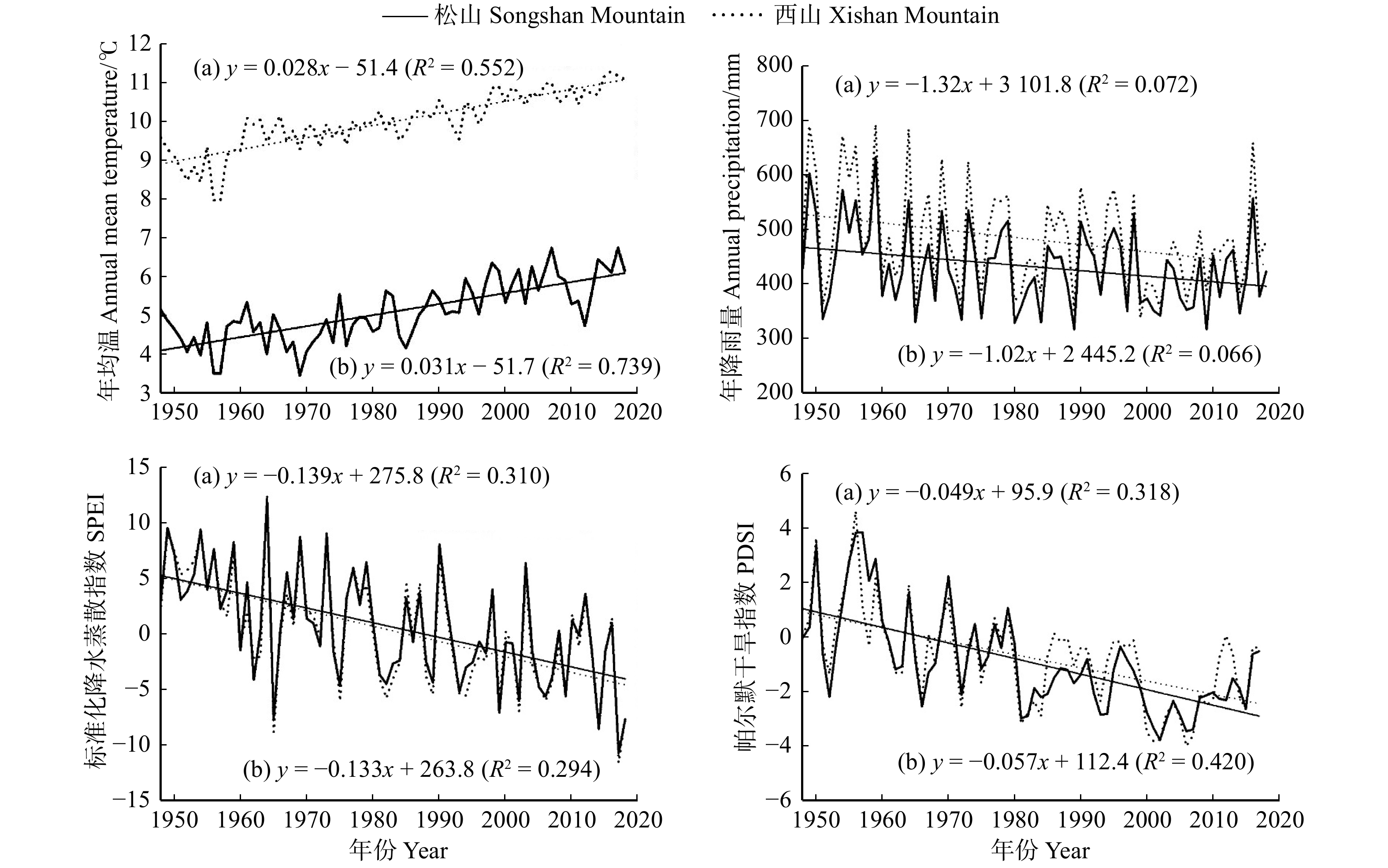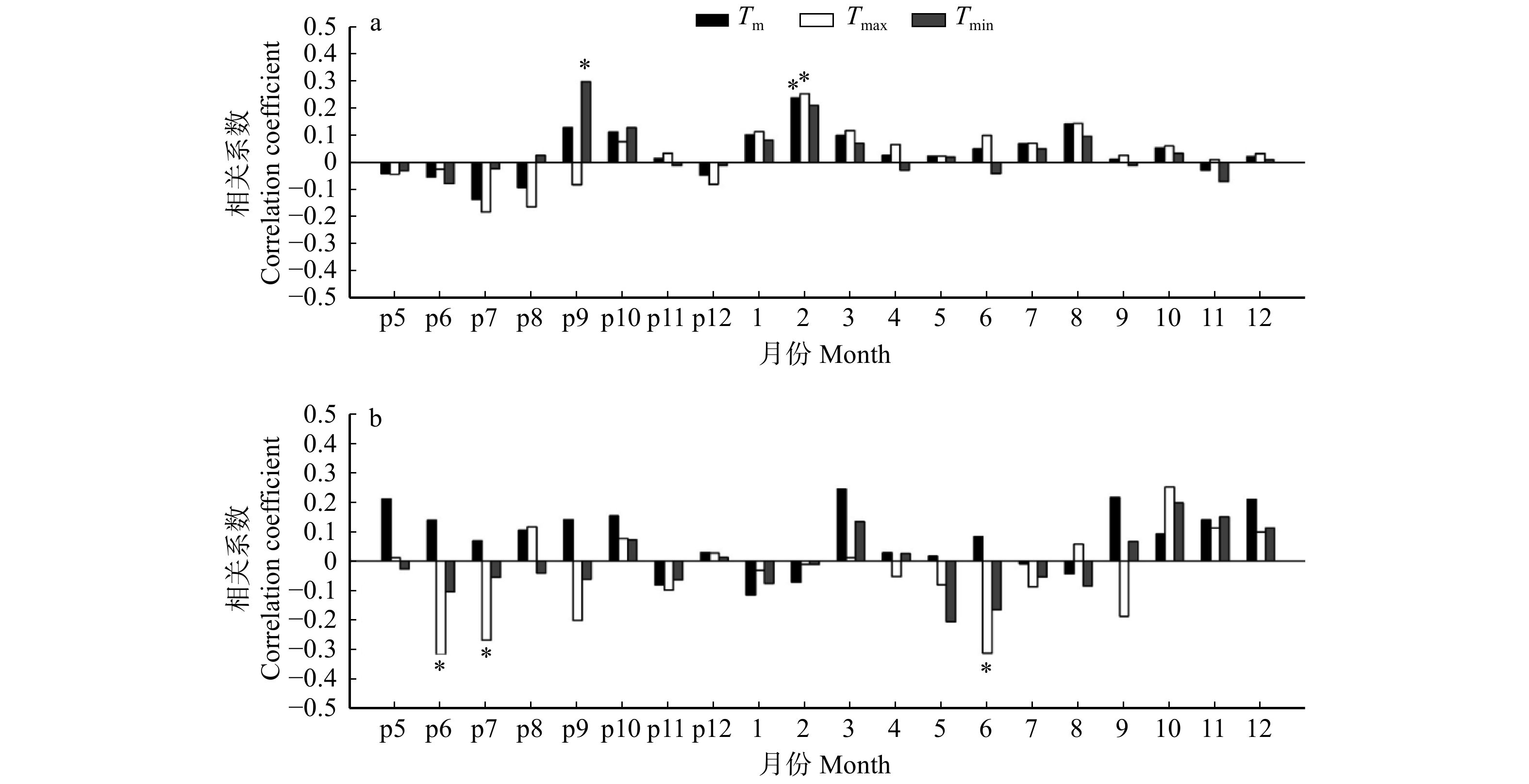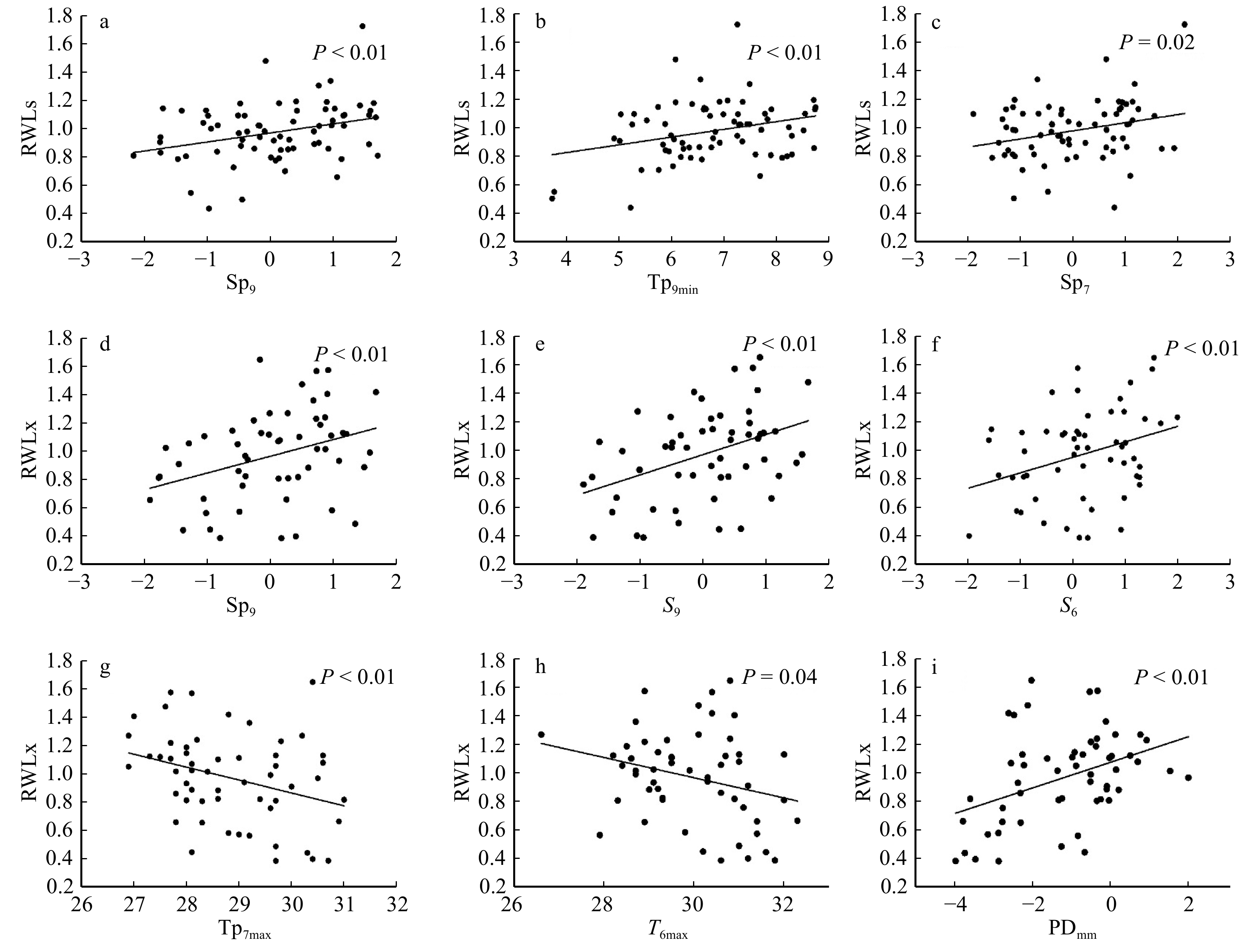Comparative study on the effects of climate change on radial growth of Pinus tabuliformis in near and outer suburbs of Beijing
-
摘要:目的 以气候变暖为主的气候变化对树木健康及生态系统的稳定产生了深刻影响。本文通过研究气候变化对远郊油松天然林和近郊油松人工林径向生长的影响,揭示城市远郊自然生态系统和近郊山地树木径向生长对气候敏感度的差别。方法 建立了远郊和近郊油松林的标准年表及差值年表,分别与气候指标进行相关分析;利用R软件建立年轮指数与气候指标的最优模型;通过4个韧性力指标分析近郊油松径向生长对干旱条件的响应。结果 (1)两地均呈现气候暖干化现象,其中近郊地区气候暖干化现象更为严重。(2)年表中统计参数均显示,近郊油松径向生长对气候信息更敏感。(3)远郊油松径向生长与当年及上年秋冬季最低温、上年夏秋季标准化降水蒸散指数(SPEI)呈显著正相关;近郊油松径向生长与上年及当年夏季极高温呈显著负相关,与上年及当年夏秋两季的SPEI呈显著正相关;近郊油松径向生长与当年帕尔默干旱指数(PDSI)年均值呈显著正相关,且严重干旱事件期间对PDSI变化更敏感。结论 远郊油松天然林和近郊油松人工林树木径向生长均存在“滞后效应”,近郊油松林的树木径向生长受城市化的影响,对极端气候的响应更加敏感,更易受到夏季高温和干旱胁迫的影响;但是,在不超过承受阈值的前提下,近郊油松人工林树木径向生长可从长期干旱事件中恢复。Abstract:Objective Climate change dominated by climate warming has had a profound impact on tree health and ecosystem stability. By studying the impact of climate change on the radial growth of Chinese pine (Pinus tabuliformis) natural forest in the outer suburbs and Chinese pine
plantation in the near suburbs, this paper reveals the difference of radial growth sensitivity of natural ecosystem in the outer suburbs and mountain trees in the near suburbs. Method The standard chronology and residual chronology of Chinese pine in the outer suburb forest and near suburb plantation were established, and their relationship with climate indicators was conducted. R software was applied to construct an optimum model for the response of tree ring index to climate indicators. The response of radial growth of Chinese pine to drought was also analyzed based on four resilience indexes.Result Both sites showed climatic warming and drying trend, which was more significant in the suburban area. The results from both chronologies showed that the radial growth of Chinese pine in suburban area was more sensitive to climate indicators. The radial growth of Chinese pine at the outer suburban site was significantly and positively related to the minimum temperature in fall and winter, also the standardized precipitation evapotranspiration index (SPEI) in the last summer and fall. The radial growth of Chinese pine at the near suburban site was significantly and negatively correlated with the daily maximum ground temperature of summer in the last and current years, and was significantly and positively correlated with SPEI of summer and autumn in the last and current years. It was also significantly and positively correlated with the annual mean Palmer drought severity index (PDSI), and was more sensitive to changes in PDSI during severe drought events.Conclusion There is a “lag effect” of the growth response to climate change at both the outer suburb forest site and near suburb plantation site. During the process of urbanization, the radial growth of Chinese pine is more sensitive to climate change, and more vulnerable to summer heat and drought stress. However, within the tolerance threshold, the Chinese pine plantation at near suburb site has the ability to recover from long-term drought events.-
Keywords:
- radial growth /
- drought stress /
- climate change /
- Pinus tabuliformis /
- urbanization
-
《北京林业大学学报》(原名《北京林学院学报》)创刊于1979年,由教育部主管、北京林业大学主办,国内外公开发行。历任主编分别为我国6位著名林学家汪振儒、沈国舫、关毓秀、王九龄、贺庆棠、尹伟伦。
《北京林业大学学报》是中文核心期刊、中国科技核心期刊、中国科学引文数据库统计源期刊、中国科技论文统计源期刊。荣获第二届国家期刊奖提名奖、第三届国家期刊奖百种重点期刊、中国精品科技期刊、中国高校精品科技期刊、中国国际影响力优秀学术期刊、“中国科技论文在线优秀期刊”一等奖等。
连续收录《北京林业大学学报》的著名检索期刊和数据库有:美国《化学文摘》(CA)、俄罗斯《文摘杂志》(AJ)、英国国际农业与生物学数据库(CABI)、英国《动物学记录》(ZR)、中国科学引文数据库(CSCD)、中国科技论文统计与引文分析数据库(CSTPCD)、《中国学术期刊文摘》《中国生物学文摘》、中国林业科技文献数据库等。
《北京林业大学学报》是中国最有代表性的林业科学期刊之一,主要刊登代表中国林业科学研究前沿创新水平的稿件。期刊定位为“立足中国,面向世界”的全国性林业科学期刊。面向国内外作者广泛征稿,对校内外稿件的质量要求一视同仁。
为保持学科特色,《北京林业大学学报》重点报道以林木遗传育种学、森林培育学、森林经理学、森林生态学、树木生理学、森林土壤学、森林植物学、森林保护学、自然保护区学、园林植物与观赏园艺、风景园林、水土保持与荒漠化防治、森林工程、木材科学与技术、林产化学加工工程、其他学科在林学上的应用等方面的论文。
《北京林业大学学报》现拥有以北京林业大学、中国林业科学研究院、中国科学院、国内其他综合性大学、农林院校、工科院校以及国外有关科研机构和大学等单位的研究人员为主的作者队伍。近年来随着期刊学术水平和影响因子的不断提高,投稿量显著增加,其中校外作者的投稿量占总收稿量的2/3左右。在此,我们对所有给《北京林业大学学报》赐稿的作者表示衷心的感谢!
《北京林业大学学报》自2015年起由原来的双月刊改为单月刊,大16开本,每月月底出版。每期定价50元。各地邮局发行,邮发代号:82−304。国内统一刊号:CN 11−1932/S。如当地邮局订阅不便或错过征订时间,也可直接汇款向本刊编辑部订阅。
地址:北京市海淀区清华东路35号《北京林业大学学报》编辑部
邮编:100083 发行电话:010−62338397 联系人:刘大林
发行电子信箱:liudalin@bjfu.edu.cn
网址:http://j.bjfu.edu.cn,http://journal.bjfu.edu.cn
-
图 2 年表年轮指数与月气温的相关系数
a 为近郊地区(西山),b 为远郊地区(松山)。Tm代表月均温,Tmin 代表月最低温,Tmax代表月最高温。*表示在P < 0.05水平达到显著差异性,**表示在P < 0.01水平达到极显著差异性。p5 ~ p12为上年5—12月月份。下同。a represents near suburbs (Xishan Mountain) and b represents outer suburbs (Songshan Mountain). Tm represents monthly mean temperature, Tmin represents monthly minimum temperature, Tmax represents monthly maximum temperature. * means significant difference at P < 0.05 level, and ** means very significant difference at P < 0.01 level. p5−p12 represent the months from May to December of previous year. The same below.
Figure 2. Correlation coefficients between the annual ring index in chronology and monthly temperature
图 4 远郊、近郊树木年轮指数与主导影响因子的变化趋势
RWLs为远郊油松年轮宽度,RWLx为近郊油松年轮宽度。a ~ c为远郊年轮指数与主导因子的变化趋势,d ~ i为近郊年轮指数与主导因子的变化趋势。RWLs represents annual ring width of outer suburban Pinus tabuliformis, RWLx represents annual ring width of near suburban P. tabuliformis. a − c are the changing trend of RWLs and dominant influencing factors; d−i are the changing trend of RWLx and dominant influencing factors.
Figure 4. Changing trend of RWLs in outer suburbs, RWLx in near suburbs and their dominant influencing factors
表 1 北京远郊地区与近郊地区采样点概况
Table 1 Description of the sampling sites in near and outer suburbs of Beijing
采样点区域
Sampling point area经度
Longitude纬度
Latitude平均树高
Mean tree
height/m平均胸径
Mean
DBH/cm平均林龄/a
Mean stand
age/year土壤类型
Soil type海拔
Elevation/m远郊(松山)
Outer suburbs (Songshan Mountain)115°48′E 40°31′N 14.2 25.2 48 山地褐土、棕色森林土
Mountain cinnamon soil,
brown forest soil1 200 近郊(西山)
Near suburbs (Xishan Mountain)116°26′E 39°98′N 13.5 22.1 43 山地褐土
Mountain cinnamon soil340 表 2 气候因子指标及说明
Table 2 Climate factor indexes and description
指标
Index说明
DescriptionTimax 当年i月的最高气温 The highest temperature in the ith month Timin 当年i月的最低气温 The lowest temperature in the ith month Tim 当年i月的平均温 Average temperature in the ith month in that year Pi 当年i月的降水量 Precipitation in the ith month in that year Tpimax 前一年i月的最高气温 The highest temperature in the ith month of previous year Tpimin 前一年i月的最低气温 The lowest temperature in the ith month of previous year Tpim 前一年i月的平均温 Average temperature in the ith month of previous year Ppi 前一年i月的降水量 Precipitation of the ith month of previous year Ta m 年平均气温 Annual average temperature Pa 年降水量 Annual precipitation Si 当年i月的SPEI值 SPEI value of the ith month in that year Spi 前一年i月的SPEI值 SPEI value of the ith month of previous year Smm 当年SPEI的月均值 Monthly average SPEI value in that year PDi 当年i月的PDSI值 PDSI value of the ith month in that year PDpi 前一年i月的PDSI值 PDSI value of the ith month of previous year PDmm 当年PDSI的月均值 Monthly mean PDSI value in that year 表 3 不同干旱程度等级划分及近郊油松平均年轮宽度与当年PDSI的Pearson相关性
Table 3 Classification of different drought degrees and Pearson correlation between average annual ring width ofPinus tabuliformis in near suburbs and PDSI in that year
干旱程度 Drought degree 正常 Normal 初始干旱 Initial drought 轻度干旱 Mild drought 严重干旱 Severe drought PDSI取值范围 Value range of PDSI (−0.5 ~ 0.5] (−1 ~ −0.5] (−2 ~ −1] (−4 ~ −2] 相关性 Correlation 0.091 0.454 0.244 0.562** 表 4 远郊天然林及近郊人工林年表的统计参数及公共区间分析结果
Table 4 Statistical parameters of chronology of natural forest in outer suburbs and plantation in near suburbs and analysis results in common intervals
统计参数 Statistic parameter 标准年表 Standard chronology 差值年表 Residual chronology 远郊天然林
Natural forest
in outer suburbs近郊人工林
Plantation
in near suburbs远郊天然林
Natural forest
in outer suburbs近郊人工林
Plantation
in near suburbs年表长度/a Chronology length/year 71 55 71 55 公共区间 Common interval 1987—2011 1975—2012 1987—2011 1975—2012 平均敏感度 Mean sensitivity 0.194 0.247 0.238 0.272 标准差 Standard deviation 0.208 0.317 0.207 0.231 树间相关系数 Correlation coefficient between trees 0.282 0.343 0.282 0.281 一阶自相关系数 First order autocorrelation coefficient 0.210 0.620 −0.095 0.020 信噪比 Signal-to-noise rate 5.503 14.087 5.509 10.538 样本总体代表性 Sample population representativeness 0.846 0.934 0.846 0.913 第一主成分方差解释量 Variance explanatory quantity of the first principal component/% 35.18 41.49 35.78 36.02 表 5 严重干旱条件下近郊油松人工林的韧性
Table 5 Resilience of Pinus tabuliformis plantation in near suburbs under severe drought conditions
干旱事件发生年份
Year of drought event抵抗力 Resistance 恢复力 Recovery 韧性 Resilience 远郊 Outer suburbs 近郊 Near suburbs 远郊 Outer suburbs 近郊 Near suburbs 远郊 Outer suburbs 近郊 Near suburbs 1966 1.126 1.130 0.808 0.792 0.910 0.894 1972 0.886 0.821 0.962 0.921 0.852 0.756 1981—1984 1.032 0.557 0.945 1.353 0.975 0.754 1993 0.828 0.687 1.151 0.854 0.953 0.586 2000—2010 0.954 1.027 0.880 1.639 0.840 1.684 2014—2015 1.235 1.100 0.900 0.816 1.111 0.898 均值 Mean 1.010 ± 0.139 0.887 ± 0.235 0.941 ± 0.106 1.063 ± 0.350 0.940 ± 0.091 0.929 ± 0.387 -
[1] 王姮, 李明诗. 气候变化对森林生态系统的主要影响述评[J]. 南京林业大学学报(自然科学版), 2016, 40(6):167−173. Wang Y, Li M S. A review of the major impacts of climate change on forest ecosystems[J]. Journal of Nanjing Forestry University (Natural Science Edition), 2016, 40(6): 167−173.
[2] 徐雨晴, 周波涛, 於琍, 等. 气候变化背景下中国未来森林生态系统服务价值的时空特征[J]. 生态学报, 2018, 38(6):1952−1963. Xu Y Q, Zhou B T, Yu L, et al. Space and temporal characteristics of future forest ecosystem service values in China under climate change[J]. Acta Ecologica Sinica, 2018, 38(6): 1952−1963.
[3] Thompson I, Mackey B, Mcnulty S, et al. Forest resilience, biodiversity, and climate change: a synthesis of the biodiversity/resilience/stability relationship in forest ecosystems[J]. CBD Technical, 2009, 43: 1−67.
[4] Ali A. Forest stand structure and functioning: current knowledge and future challenges[J]. Ecological Indicators, 2019, 98: 665−677. doi: 10.1016/j.ecolind.2018.11.017
[5] O’Connor C D, Falk D A, Lynch A M, et al. Disturbance and productivity interactions mediate stability of forest composition and structure[J]. Ecological Applications, 2017, 27(3): 900−915. doi: 10.1002/eap.1492
[6] 罗鑫玥, 陈明星. 城镇化对气候变化影响的研究进展[J]. 地球科学进展, 2019, 34(9):984−997. Luo X Y, Chen M X. Research progress on the impact of urbanization on climate change[J]. Advances in Earth Science, 2019, 34(9): 984−997.
[7] Fu Y C, Li J F, Weng Q H, et al. Characterizing the spatial pattern of annual urban growth by using time series landsat imagery[J]. Science of the Total Environment, 2019, 666: 274−284. doi: 10.1016/j.scitotenv.2019.02.178
[8] 王婷, 于丹, 李江风, 等. 树木年轮宽度与气候变化关系研究进展[J]. 植物生态学报, 2003, 27(1):23−33. doi: 10.3321/j.issn:1005-264X.2003.01.004 Wang T, Yu D, Li J F, et al. Advances in research on the relationship between climatic change and tree-ring width[J]. Acta Phytoecologica Sinica, 2003, 27(1): 23−33. doi: 10.3321/j.issn:1005-264X.2003.01.004
[9] 魏本勇, 方修琦. 树轮气候学中树木年轮密度分析方法的研究进展[J]. 古地理学报, 2008, 10(2):193−202. doi: 10.7605/gdlxb.2008.02.009 Wei B Y, Fang X Q. Advances on the methodology of tree-ring density analysis in dendroclimatology[J]. Journal of Palaeogeography, 2008, 10(2): 193−202. doi: 10.7605/gdlxb.2008.02.009
[10] 郑淑霞, 上官周平. 树木年轮与气候变化关系研究[J]. 林业科学, 2006, 42(6):100−107. doi: 10.3321/j.issn:1001-7488.2006.06.017 Zheng S X, Shangguan Z P. Study on relationship between tree-ring and climatic change[J]. Scientia Silvae Sinicae, 2006, 42(6): 100−107. doi: 10.3321/j.issn:1001-7488.2006.06.017
[11] 高露双. 长白山典型树种径向生长与气候因子的关系研究[D]. 北京: 北京林业大学, 2011. Gao L S. Relationship between radial growth and climatic factors of typical tree species in Changbai Mountain [D]. Beijing: Beijing Forestry University, 2011.
[12] Romagnoli M, Moroni S, Recanatesi F, et al. Climate factors and oak decline based on tree-ring analysis: a case study of peri-urban forest in the Mediterranean area[J]. Urban Forestry & Urban Greening, 2018, 34: 17−28.
[13] Vasconcellos T J D, Tomazello-Filho M, Callado C H. Dendrochronology and dendroclimatology of Ceiba speciosa (A. St.-Hil.) Ravenna (Malvaceae) exposed to urban pollution in Rio de Janeiro City, Brazil[J]. Dendrochronologia, 2019, 53: 104−113. doi: 10.1016/j.dendro.2018.12.004
[14] 成泽虎. 基于树轮宽度的北京松山油松林生长—气候关系研究[D]. 北京: 北京林业大学, 2016. Cheng Z H. Response of Pinus tabulaeformis forests to climate change based on tree-ring data in Songshan, Beijing, China[D]. Beijing: Beijing Forestry University, 2016.
[15] 高佳妮, 杨保, 秦春. 树木年内径向生长对干旱事件的响应:以贺兰山油松为例[J]. 应用生态学报, 2021, 32(10):3505−3511. Gao J N, Yang B, Qin C. Response of intra-annual stem radial growth to drought events: a case study of Pinus tabuliformis in the Helan Mountains, China[J]. Chinese Journal of Applied Ecology, 2021, 32(10): 3505−3511.
[16] 冯娟, 华亚伟, 张志成, 等. 秦岭南坡镇安油松径向生长−气候因子关系对气温突变的响应[J]. 植物科学学报, 2021, 39(3):268−277. doi: 10.11913/PSJ.2095-0837.2021.30268 Feng J, Hua Y W, Zhang Z C, et al. Response of the relationship between Pinus tabuliformis Carr. radial growth and climatic factors to abrupt changes in temperature in Qinling Zhen’an[J]. Plant Science Journal, 2021, 39(3): 268−277. doi: 10.11913/PSJ.2095-0837.2021.30268
[17] 赵莹, 蔡立新, 靳雨婷, 等. 暖干化加剧东北半干旱地区油松人工林径向生长的水分限制[J]. 应用生态学报, 2021, 32(10):3459−3467. Zhao Y, Cai L X, Jin Y T, et al. Warming-drying climate intensifies the restriction of moisture on radial growth of Pinus tabuliformis plantation in semi-arid area of northeast China[J]. Chinese Journal of Applied Ecology, 2021, 32(10): 3459−3467.
[18] 姜庆彪, 赵秀海, 高露双, 等. 不同径级油松径向生长对气候的响应[J]. 生态学报, 2012, 32(12):3859−3865. doi: 10.5846/stxb201109091323 Jiang Q B, Zhao X H, Gao L S, et al. Growth response to climate in Chinese pine as a function of tree diameter[J]. Acta Ecologica Sinica, 2012, 32(12): 3859−3865. doi: 10.5846/stxb201109091323
[19] 张更喜, 粟晓玲, 郝丽娜, 等. 基于NDVI和scPDSI研究1982—2015年中国植被对干旱的响应[J]. 农业工程学报, 2019, 35(20):145−151. doi: 10.11975/j.issn.1002-6819.2019.20.018 Zhang G X, Li X L, Hao L N, et al. Response of vegetation to drought based on NDVI and scPDSI data sets from 1982 to 2015 across China[J]. Transactions of the Chinese Society of Agricultural Engineering (Transactions of the CSAE), 2019, 35(20): 145−151. doi: 10.11975/j.issn.1002-6819.2019.20.018
[20] 崔诗梦, 向玮. 间伐与气候对长白落叶松树轮宽度的影响[J]. 林业科学, 2017, 53(12): 1−11. Cui S M, Xiang W. Effects of thinning and climate factors on Larix olgensis tree-ring width[J]. Scientia Silvae Sinicae, 2017, 53(12): 1−11.
[21] 申佳艳, 李帅锋, 黄小波, 等. 南盘江流域云南松径向生长对气候暖干化的响应[J]. 植物生态学报, 2019, 43(11):946−958. doi: 10.17521/cjpe.2019.0169 Shen J Y, Li S F, Huang X B, et al. Radial growth responses to climate warming and drying in Pinus yunnanensis in Nanpan River Basin[J]. Chinese Journal of Plant Ecology, 2019, 43(11): 946−958. doi: 10.17521/cjpe.2019.0169
[22] 张同文, 袁玉江, 魏文寿, 等. 开都河流域天山桦树轮宽度年表的建立及其气候响应[J]. 生态学报, 2015, 35(9): 3034−3042. Zhang T W, Yuan Y J, Wei W S, et al. Development of the tree-ring width chronology of Betula tianschanica for the Kaiduhe River Watershed and its climate response[J]. Acta Ecologica Sinica, 2015, 35(9) : 3034−3042.
[23] Lloret F, Keeling E G, Sala A. Components of tree resilience: effects of successive low-growth episodes in old ponderosa pine forests[J]. Oikos, 2011, 120(12): 1909−1920. doi: 10.1111/j.1600-0706.2011.19372.x
[24] 高露双, 赵秀海, 张赟. 温度、降水与树木径向生长关系研究现状[J]. 浙江林业科技, 2007, 27(4):76−79. doi: 10.3969/j.issn.1001-3776.2007.04.019 Gao L S, Zhao X H, Zhang Y. Research status of relationship between temperature, precipitation and radial growth of trees[J]. Zhejiang Forestry Science and Technology, 2007, 27(4): 76−79. doi: 10.3969/j.issn.1001-3776.2007.04.019
[25] Ögren E, Nilsson T, Sundblad L G. Relationship between respiratory depletion of sugars and loss of cold hardiness in coniferous seedlings over-wintering at raised temperatures: indications of different sensitivities of spruce and pine[J]. Plant, Cell and Environment, 1997, 20(2): 247−253. doi: 10.1046/j.1365-3040.1997.d01-56.x
[26] Nitschke C R, Nichols S, Allen K, et al. The influence of climate and drought on urban tree growth in southeast Australia and the implications for future growth under climate change[J]. Landscape and Urban Planning, 2017, 167: 275−287. doi: 10.1016/j.landurbplan.2017.06.012
[27] Galiano L, Martínez-Vilalta J, Lloret F. Carbon reserves and canopy defoliation determine the recovery of Scots pine 4 yr after a drought episode[J]. New Phytologist, 2011, 190(3): 750−759. doi: 10.1111/j.1469-8137.2010.03628.x
[28] 程瑞梅, 刘泽彬, 封晓辉, 等. 气候变化对树木木质部生长影响的研究进展[J]. 林业科学, 2015,51(6):147−154. Cheng R M, Liu Z B, Feng X H, et al. Advances in research on the effect of climatic change on xylem growth of trees[J]. Scientia Silvae Sinicae, 2015,51(6): 147−154.
[29] Dahlhausen J, Rötzer T, Biber P, et al. Urban climate modifies tree growth in Berlin[J]. International Journal of Biometeorology, 2018, 62(5): 795−808. doi: 10.1007/s00484-017-1481-3
[30] 李金航, 周玫, 朱济友, 等. 黄栌幼苗根系构型对土壤养分胁迫环境的适应性研究[J]. 北京林业大学学报, 2020, 42(3):65−77. doi: 10.12171/j.1000-1522.20190218 Li J H, Zhou M, Zhou J Y, et al. Adaptability response of root architecture of Cotinus coggygria seedlings to soil nutrient stress[J]. Journal of Beijing Forestry University, 2020, 42(3): 65−77. doi: 10.12171/j.1000-1522.20190218
[31] 刘敏, 毛子军, 厉悦, 等. 不同径级红松径向生长对气候变化的响应[J]. 应用生态学报, 2018, 29(11):3530−3540. Liu M, Mao Z J, Li Y, et al. Response of radial growth to climate change in Pinus koraiensis with different diameter classes[J]. Chinese Journal of Applied Ecology, 2018, 29(11): 3530−3540.




 下载:
下载:



